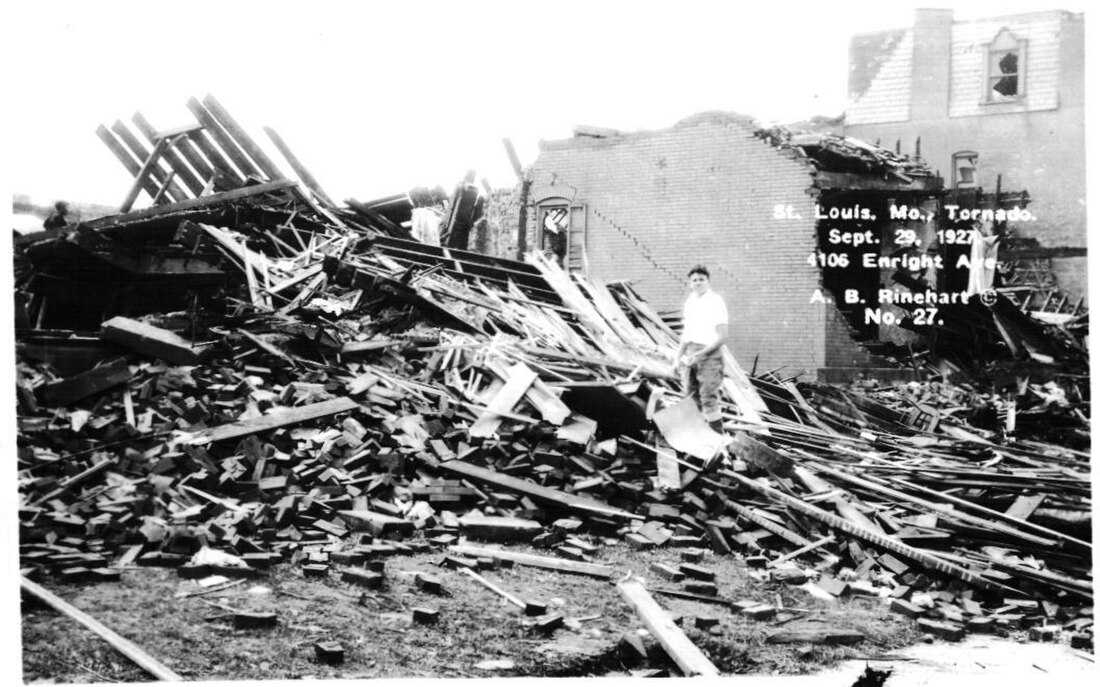Top Qs
Timeline
Chat
Perspective
Tornado outbreak of September 29, 1927
Extreme weather event in central US From Wikipedia, the free encyclopedia
Remove ads
On Thursday, September 29, 1927, an outbreak of at least 15 significant tornadoes, including three F3 tornadoes, killed at least 82 people in the Central United States, particularly in Missouri and Illinois. The outbreak affected a broad expanse of the Midwestern and Southern United States, including Oklahoma, Missouri, Arkansas, Iowa, Illinois, and Indiana. The deadliest tornado was an estimated F3 which affected portions of Greater St. Louis, killing at least 79 people and injuring at least 550 others. The tornado narrowly missed Downtown St. Louis, striking north of the central business district before crossing the Mississippi River.[2][3][4][nb 2][nb 3][nb 4]
Remove ads
Confirmed tornadoes
Summarize
Perspective
September 29 event
St. Louis, Missouri–East St. Louis, Illinois
The 1927 St. Louis–East St. Louis tornado was a powerful and devastating tornado that struck St. Louis, Missouri, on Thursday, September 29, 1927, at about 1:00 p.m. local standard time. The tornado is estimated to have reached at least F3 and possible F4 intensity on the Fujita scale. The 2nd deadliest tornado to occur in the St. Louis metropolitan area, it caused 79 deaths—though totals vary from 72 to 84—and injured more than 550 people within a 7-to-12-mile-long (11 to 19 km), 100-to-600-yard-wide (91 to 549 m) path. At one time it was the second-costliest tornado in U.S. history. More than 200 city blocks were destroyed. St. Louis University High School was hit hard. The student chapel's roof collapsed, the gym's (now main offices) roof was damaged, an entire classroom caved in on a class, and other classrooms were damaged. All the windows were smashed. Luckily, no one was killed or badly injured. The tornado caused $150,000 in damage to the school.[18][19][20][21][22][23][24]
Remove ads
See also
Notes
- An outbreak is generally defined as a group of at least six tornadoes (the number sometimes varies slightly according to local climatology) with no more than a six-hour gap between individual tornadoes. An outbreak sequence, prior to (after) the start of modern records in 1950, is defined as a period of no more than two (one) consecutive days without at least one significant (F2 or stronger) tornado.[5]
- The Fujita scale was devised under the aegis of scientist T. Theodore Fujita in the early 1970s. Prior to the advent of the scale in 1971, tornadoes in the United States were officially unrated.[6][7] While the Fujita scale has been superseded by the Enhanced Fujita scale in the U.S. since February 1, 2007,[8] Canada used the old scale until April 1, 2013;[9] nations elsewhere, like the United Kingdom, apply other classifications such as the TORRO scale.[10]
- Historically, the number of tornadoes globally and in the United States was and is likely underrepresented: research by Grazulis on annual tornado activity suggests that, as of 2001, only 53% of yearly U.S. tornadoes were officially recorded. Documentation of tornadoes outside the United States was historically less exhaustive, owing to the lack of monitors in many nations and, in some cases, to internal political controls on public information.[11] Most countries only recorded tornadoes that produced severe damage or loss of life.[12] Significant low biases in U.S. tornado counts likely occurred through the early 1990s, when advanced NEXRAD was first installed and the National Weather Service began comprehensively verifying tornado occurrences.[13]
- All dates are based on the local time zone where the tornado touched down; however, all times are in Coordinated Universal Time and dates are split at midnight CST/CDT for consistency.
References
Sources
Wikiwand - on
Seamless Wikipedia browsing. On steroids.
Remove ads


